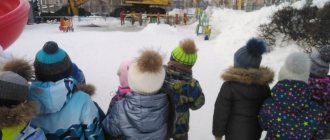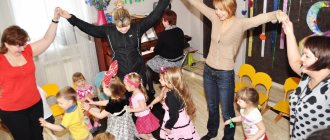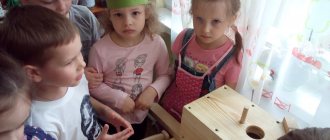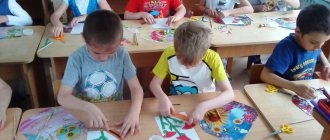Topic: “Furniture. Furniture parts." Week from to Senior group. Teacher Korotkova O.V. Monday
Transcript
1 Topic: “Furniture. Furniture parts." Week from to Senior group Teacher Korotkova O.V. Monday Cognition (familiarization with the world around you). “Furniture in our house” Goal: To expand and systematize children’s ideas about furniture and their purpose. Learn to distinguish and name furniture parts. Fix the general concept of “furniture”. Visual activity “My Room” Purpose: to learn to compare objects of different sizes and shapes, arrange them on a sheet of paper, and use various techniques for depicting various complex objects.
2 Physical education Purpose: to exercise children in walking and running in a circle, turning in the other direction; learn to jump from foot to foot moving forward; practice crawling on all fours between pins, tossing and catching a ball. Outdoor game. “Don’t stay on the floor” Goal: develop the ability to act on a signal, restrain yourself, and perform movements expressively. Didactic game “What does it look like” Purpose: consolidation of knowledge of geometric shapes, development of observation and attention. Role-playing game “Furniture Store” Goal: to promote the development of a new plot, develop the ability to choose a role, develop the ability to fulfill a role to the end, cultivate partnerships, and develop sociocultural competencies. Recommendations for parents: Cultivate a caring attitude towards things made by human hands, an understanding of the importance of work that benefits people. Fix the name of furniture items and parts of furniture. Tuesday Cognition (FEMP) “Furniture salon” Goal: developing the ability to establish a correspondence between the number of objects and the number. Learn to compare the outline of numbers, establish their similarities and differences.
3 Outdoor game. “Pathfinders” Goal: improving coordination of movements, developing motor skills. Didactic game “What is needed for what?” Goal: develop curiosity and attention; fix the names of pieces of furniture and their functional purpose. Role-playing game “Let's arrange a room for the doll” Goal: to promote the development of a new plot, develop the ability to choose a role, develop the ability to fulfill a role to the end, and cultivate partnerships. Recommendations for parents: teach children to count to 10, reinforce the concept of quantity, teach them to find objects of different shapes, develop ideas about how to make another from one shape. Environment Application “Furniture in my house” Purpose: to teach how to create a simple composition, select the color of images, and complement the composition with characteristic details. Strengthen the ability to arrange images of furniture in different ways in the space of a sheet of paper. Practice neat cutting and pasting.
4 Physical education (outdoors) Goal: repeat walking and running between snow buildings; practice throwing snowballs at a target; repeat the game “Frost-Red Nose” Outdoor game. “Hunters and Hares” Goal: to develop motor skills, speed and attention. Didactic game “Listen, repeat, don’t change the words” Goal: to develop phonemic hearing, short-term auditory memory.. Role-playing game “Housewarming” Goal: to expand the understanding of furniture and its purpose, to promote the development of a new plot, to develop the ability to choose a role, to form the ability to fulfill a role to the end, cultivate partnerships Recommendations for parents: strengthen children’s skills in creating images from paper (cut paper into strips, cut out circles, transform one geometric shape into another. Thursday
5 Development of speech “In the cabinetmaker’s workshop.” Goal: to develop the ability to compose short descriptive stories according to the plan proposed by the teacher. Learn to form possessive adjectives (pine, oak, etc.) Develop auditory and visual memory. Physical education Purpose: to train children to walk and run between objects without touching them; continue to form stable balance when walking and running on an inclined board; practice jumping from foot to foot, throwing the ball into the hoop, developing dexterity and eye. Outdoor game. “Bears and Bees” Goal: to develop motor skills, speed and attention. Didactic game "Guess"
6 Purpose: to clarify the names of objects and their purposes, to learn to compare individual pieces of furniture, to describe them. Role-playing game “A Doll’s House” Goal: to promote the development of a new plot, develop the ability to choose a role, and develop the ability to fulfill a role to the end. Recommendations for parents: develop the child’s speech as a means of communication. Train children in the ability to combine a noun with an adjective, change words using a diminutive suffix. Friday Handmade “Furniture Workshop”. (making furniture from waste material) Goal: to develop fine motor skills, to form constructive activities when creating furniture from waste material, to introduce children to work. Reading fiction. S.Ya. Marshak “Where did the table come from?” Goal: to teach children to perceive short literary works; explain unclear words; pose questions to the text, answer the questions posed.
7 Outdoor game. “As you drive more quietly, you will continue” Goal: to develop motor skills, develop speed, agility, and the ability to listen to commands. Didactic game “Name the parts that make up the furniture” Purpose: to consolidate children’s ideas on the topic, to activate the vocabulary. Role-playing game “Furniture Salon” Purpose: To develop attention, promote the development of a new plot, develop the ability to choose a role, develop the ability to fulfill a role to the end. Recommendations for parents: develop the child’s interest in visual arts. Enrich their sensory experience by developing their senses of perception: vision, hearing, smell, touch, taste; consolidate knowledge about the basic forms of objects and natural objects.
"Furniture". Calendar and thematic planning
Svetlana Shevtsova
"Furniture". Calendar and thematic planning
Topic of the week: " Furniture "
.
Goal: To consolidate the general concept of “ furniture ”
.
Summarize, clarify and activate children's vocabulary. Develop children's cognitive interest. Final event: Re-enactment of the fairy tale “The Cat's House”
Y/N
Mode Joint activities between adults and children Educational activities during restricted periods Organizing a developmental environment for children’s independent activities Working with parents
Subgroup/group
Individual
February 25, 2022, Monday Morning Reception of children.
Speech games and exercises “Say a lot”
,
“Which sound is stressed?”
,
“Tell me which one?”
Goal: Improving general speech skills, activating speech motor analyzers.
Morning exercises No. 23 Duty for classes. Purpose: To improve the skills of independently laying out handouts, taking into account aesthetics and the number of children.
with "Dangerous objects"
Goal: To reinforce the rules of safe behavior in the house, to clearly show how some pieces of
furniture can become dangerous. Organize illustrations, subject and subject pictures on the topic, a mnemonic table for describing furniture , children's furniture , fiction on the topic.
Conversations on issues of interest to parents GCD 1. Communication activities (Speech development.)
Topic: Didactic games with words. Reading fables."
Program objectives: Develop attention and speech. Activate children's vocabulary. Cultivate perseverance and love for the Russian language. (Speech development in kindergarten / V.V. Gerbova p. 100)
Corrective and developmental activity.
2. Motor activity (Physical education.)
Program objectives: Exercise children in continuous running; in climbing a gymnastic wall without missing the slats; practice maintaining balance when walking on increased support; repeat tasks in jumping and with a ball. (L. I. Penzulaeva “Physical culture in kindergarten. Senior group”
pp. 73-75)
Walk Observing a sparrow in winter - continue to consolidate knowledge about the sparrow;
Labor: collecting garbage on the site - foster mutual assistance.
P/i "Migration of birds"
- learn to act on a signal.
“Dexterous pair”
- throw the ball at an angle. Individual work: strengthen the ability to throw the ball at the target.
with Didactic game “What has changed?”
- develop attention and memory.
Research activity - compare magpie and tit. Organize work with external material (Lego constructor)
Goal: Continue teaching children to form small groups.
Work before bed Reading the fairy tale “The Cuckoo” (German folk tale)
Ts: Continue to get acquainted with the genre of folk tales.
2nd half of the day
Walk Gradual rise, invigorating gymnastics after sleep, k/g procedures.
Free visual activity.
Goal: Continue to develop sculpting skills using various traditional and non-traditional techniques.
P/i "The third wheel"
,
“Homeless Hare” (running, reaction speed, agility)
.
“The Magic of Color”
- exercises to develop color perception, experimentally obtaining shades of flowers when they are - Caring for indoor plants: watering, spraying, loosening and fertilizing.
Goal: To develop labor skills, the ability to use the necessary tools.
Organize a s/r game “Supermarket”
Goal: To develop children’s ability to choose the most healthy products
Y/N
Mode
Joint activities between adults and children Educational activities during restricted periods Organization of a developmental environment for children’s independent activities Working with parents
Subgroup/group
Individual
February 26, 2022, Tuesday Morning Reception of children.
Conversation “Such different furniture !”
Goal: Show the variety of furniture , its meaning and practical application in human life.
Morning exercises No. 23 Exercise “Change according to the model”
(wood chair - wooden chair, metal bed - metal bed)
with Conversation on the topic: “Order in the closet”
- develop the ability to work individually and demonstrate independence.
Organize flashcards by topic
«Furniture»
, a variety of visual media, a card index of riddles about
furniture . Advice from Aibolit “5 rules for the prevention of ARVI”
GCD 1. Cognitive and research activities. (FEMP)
.
Lesson No. 24 “Orientation in space”
Program objectives: .Develop children’s attention and practice orientation on a piece of paper, using the words: “on the left”
,
“to the right”
,
“far”
,
“close”
,
“above”
,
“below”
; Learn to compare objects by height using a conventional measure.
Cultivate perseverance. (V.P. Novikova “Mathematics in kindergarten”
, p. 63)
2. Visual activity. Drawing. Topic: Drawing according to the plan “Beautiful Flowers”
(Based on folk decorative art)
Program tasks:. Develop creativity and imagination. Develop and consolidate children’s ideas and knowledge about different types
folk arts and crafts (Gorodets, Gzhel painting, etc.)
.Teach to conceive a beautiful, unusual flower.
Strengthen the ability to convey colors and their shades (mixing paints of different colors with white, using different pencil pressures). Strengthen the technical skills of drawing with different materials. Develop the ability to enjoy the overall result of the lesson. (T. S. Komarova, “Art activities in kindergarten”
, p. 99)
Walk Observing water - to form ideas about the state of water in the autumn.
Labor: cleaning the site - work together as a team.
P/game “Cold - Hot”
- practice hitting the ball,
“Sleeping Fox”
- practice running. performing balance exercises to develop endurance.
with D/i “Who needs what?”
- exercise in classifying objects according to several general characteristics.
S/r game “Daughters - Mothers”
Goal: To develop the ability to play out situations from family life, avoiding disputes and conflicts. Cultivate a respectful attitude towards peers.
Work before bed Reading the fairy tale The Mouse and the Fawn (Yakut folk tale)
Ts: Continue to get acquainted with the genre of folk tales.
2nd half of the day
Walk Gradual rise, gymnastics after sleep.
Corrective and developmental activity.
Gradual rise, gymnastics after sleep
Creative workshop “Painted Table”
Goal: Offer to decorate the table top template with elements of decorative painting using non-traditional equipment (stamps, pokes, ear sticks, crumpled paper)
.Develop visual skills P/i
“Counter dashes”
.
Goals: to increase the motor activity of children while walking; develop accuracy, agility, endurance. Folding from geometric shapes. Goal: to continue to develop children’s ability to lay out an object from geometric shapes. Develop fine motor skills, thinking, memory - Solving a problem situation.
“In the museum hall, three people looked at the paintings: a girl, an old woman and a woman who is expecting a child. There was a banquette against the wall that could only accommodate two people. Independent motor activity.
Goal: To clarify children’s ability to observe the rules of the game and follow them without creating a reason for a quarrel.
Y/N
Mode Joint activities between adults and children Educational activities during restricted periods Organizing a developmental environment for children’s independent activities Working with parents
Subgroup/group
Individual
February 27, 2022, Wednesday Morning Reception of children.
D/u “Listen, repeat, don’t change the words”
-, teach children to reproduce series of words that are similar in sound composition. Develop phonemic awareness and short-term auditory memory.
Morning exercises No. 23 D/u “First syllable”
- organize the use of the ability to divide words-names of
furniture into syllables , highlight the first syllable
with School of Politeness
Goal: Encourage the desire to show friendliness towards people. Teach children to display formulas of verbal politeness in speech. Subject pictures, card index of speech games and exercises,
a variety of visual media, illustrations and books on the topic. Consultation for parents Danil K. and Artem F. “Building independence in dressing”
GCD 1. Communication activity. Speech development. Topic: Writing a story on a given topic
Program objectives: Develop interest in the environment. Learn to compose a story on a topic proposed by the teacher; learn to compare objects, accurately denoting similarities and differences with words; find semantic inconsistencies in the text of the poem and give reasons for your judgments. Clarify the meaning of the words furniture and dishes ; learn to independently form the names of dishes; develop the ability to construct sentences. Develop speech activity.
(Development of children's speech / O. S. Ushakova p. 94)
Corrective and developmental activity.
2. Visual activity. Application Topic: “Riddles”
Program objectives: To develop imaginative ideas, imagination and creativity. Practice creating images of various objects from different geometric shapes, transforming shapes by cutting them diagonally in a straight line into several parts. Strengthen the ability to compose an image in parts from different shapes, carefully paste it. 3. Foster a love of artistic creativity. (Art activities in kindergarten by T. S. Komarova p. 106)
Walk Observing clouds - consolidate knowledge about inanimate nature.
Labor: digging up sand - teaching to see the result of labor.
Outdoor game: “Don’t knock it down and catch it”
,
“Further and Higher”
- teach how to overcome an obstacle course and jump easily.
Didactic game “Hot - cold”
- consolidate knowledge about plants.
Individual work: practice jumping over a horizontal obstacle.
With
Explanation of sayings and signs:
“You can’t sit on two chairs”
;
“The knife or fork fell - to the guest or guest”
Organize a game with your favorite toys.
Goal: to teach children to play together, share toys with each other
Work before bed Reading the fairy tale “Mice-friends”
Ts: Entertain children, teach them to react emotionally to the work.
GCD 3. Musical activity. Music. P/Z: Learn to compare two works with the same title, but different in character. Strengthen in children the ability to improvise melodies for individual musical phrases (question-answer, riddle-answer, etc., to a given text; develop modal tonal hearing, activate inner hearing; develop creative initiative;
2nd half of the day
Walk Gradual rise, gymnastics after sleep.
Holiday on the street "Broad Maslenitsa"
Goal: to expand and deepen children’s knowledge about the folklore holiday, its meanings and celebration traditions.
Develop creative abilities. To cultivate spiritual and moral qualities. P/i "Sly Fox"
running with dodging, dexterity.
To strengthen children's ability to improvise - Conversation “How they lived in the old days”
Purpose: Using illustrations, show the various interiors of the past. Independent play activities (provide play space, offer to use substitute toys)
Y/N
Mode Joint activities between adults and children Educational activities during restricted periods Organizing a developmental environment for children’s independent activities Working with parents
Subgroup/group
Individual
February 28, 2022, Thursday Morning Reception of children.
Conversation “Who makes furniture ?”
Goal: To broaden the horizons of children, to give ideas about the professions of people who make furniture .
R/i “He, she, they”
(use consistent pronouns
Morning exercises No. 23 Exercise " Furniture salon "
Goal: to develop the ability to carefully cut out geometric shapes and model pieces of
furniture .
c Continue to improve your washing skills: soap your hands until foam forms, rinse thoroughly, wash your face, Subject paintings, cards on the topic Furniture , colored paper, scissors, glue, white sheets of paper, “Geometric Shapes”
,fiction on the topic Consultation for parents Andrey Sh. and Anya M.
“A system of breathing exercises for the prevention of colds”
GCD 1. Visual activity. Drawing. Topic: “Golden Khokhloma”
Program objectives: Develop aesthetic perception, sense of color, composition.
Practice a variety of brush techniques (all bristles, ends)
. Develop the ability to admire Khokhloma products and created patterns. Continue to introduce children to products decorated
Khokhloma painting. Learn to highlight the composition of the pattern (it is arranged on a wavy stem, around a curl; name its elements: grass, curls, various berries, flowers, leaves; highlight their rhythmic arrangement; determine the color of Khokhloma: gold, black, brown background and red, orange berries; green, yellow, black (depending on background)
grass.
Cultivate a love of artistic creativity. (Art activities in kindergarten by T. S. Komarova p. 78)
2. Musical activities. Music. P/Z: Develop children's creativity, encourage them to take active independent action (choosing an instrument, improvising accompaniment, individual phrases)
. Strengthen the ability to move rhythmically and expressively at a straight gallop.
3. Motor activity. Physical culture (outdoor)
.
P/Z: Strengthen the ability to maintain balance when walking on an increased support, repeat jumping exercises (L. I. Penzulaeva “Physical culture in kindergarten. Senior group”
pp. 73-75)
Walk Observing the wind - expand children's understanding of natural phenomena.
Labor: sweep the paths on the site - teach them to maintain cleanliness.
P/i at the children's choice (running, agility, ingenuity)
Didactic game - “When does this happen?”
recognize the signs of autumn.
I/u “Count, remember, select a number” (the relationship between a number and a number)
with Research activity - determine the direction of the wind using a compass. S/r game “ Furniture ”
C: to form sociocultural competencies (possession of knowledge and experience in performing typical social roles
Work before bed Reading the nursery rhyme “We mowed, threshed...”
(Tatar)
Goal: introduce children to the nursery rhyme, learn it by heart, foster a love for Russian folklore.
2nd half of the day
Walk Gradual rise, gymnastics after sleep. Corrective and developmental activity.
Independent play activity of children is to form skills related to the communicative and regulatory functions of speech. Learn to act as organizers of game interaction.
P/i "Hunters and Hares"
.
Goals: learn to coordinate movements with each other;
develop the eye. secure a standing long jump— D/i “Guess by the description”
Goal: To develop coherent speech skills and the ability to use homogeneous definitions. Using strokes and shading, patterns and stencils to create furniture
Coloring illustrations from coloring books.
Y/N
Mode Joint activities between adults and children Educational activities during restricted periods Organizing a developmental environment for children’s independent activities Working with parents
Subgroup/group
Individual
March 1, 2022, Friday Morning Reception of children.
Conversations "Fire"
: friend or foe”,
“So that there is no trouble”
- remind children of this. that in case of careless handling of fire or electrical appliances, a fire may occur
Morning exercises No. 23 improve the ability to fold sheets of paper of different shapes in different directions
from D/u “How to make a bed”
goal: to strengthen the ability to make a bed: straighten a sheet, cover it with a blanket.
m/d/i “Listen, repeat”
goal: to teach children to perceive, distinguish and reproduce rhythmic patterns
(on a tambourine, rattle and other instruments)
Consultation for parents Vova D. and Dasha
“If a child likes to lie”
GCD 1. Cognitive and research activity. Familiarization with the objective world Topic: “Paper collector”
.
Program objectives: To develop and expand children's understanding of different types of paper and its qualities. Improve the ability to identify objects based on material characteristics. Cultivate perseverance. (Acquaintance with the subject and social environment O. V. Dybina p. 27)
2. Motor activity. Physical Culture. P/Z: Exercise children in continuous running; in climbing a gymnastic wall without missing the slats; practice maintaining balance when walking on increased support; repeat tasks in jumping and with a ball. (L. I. Penzulaeva “Physical culture in kindergarten. Senior group”
pp. 73-75)
Walk Comparison of needles and foliage of trees.
Goal: To clarify ideas about coniferous and deciduous plants, expand the conceptual vocabulary, and teach observation skills.
P/n “The slower you go, the further you will go”
,
“Pathfinders”
- improving coordination of movements, developing motor skills.
I/u “Earlier – later” (identification of temporary representations)
with Guessing riddles about various trees.
re-enactment
"Teddy bear is an ignoramus"
A. Barto.
Goal: Development of creative abilities and the desire to impromptu during correctional and developmental exercises.
Work before bed Reading the nursery rhyme “Grandma Crow...”
C: introduce children to the nursery rhyme, memorize it, cultivate a love for Russian folklore.
2nd half of the day
Walk Evening of leisure. Staging "Cat's House"
Goal: To encourage children to role-play behavior, to arouse a desire to participate in collective performances.
P/n “The slower you go, the further you will go”
,
"Pathfinders"
- improvement
coordination of movements, development of motor skills. Individual and subgroup work in graphic albums.
Goal: Performing graphic dictation, solving visual logical problems Cotton labor:
Take part in changing bed linen: lay out a clean sheet, put on a clean pillowcase.
Independent play activity.
Goal: Offer to organize a game using gaming equipment, having previously distributed the players and discussed the conditions of the game.
MAGAZINE Preschooler.RF
Calendar-thematic planning in the middle group on the topic “Furniture”Tuesday 6 November
Morning. Labor activity.
Caring for indoor plants together with a teacher.
Improving the ability to independently water indoor plants. Cultivate hard work.
Game activity.
Board and printed game “Patch the rug” ( “Patches” ).
Develop voluntary visual memory and perception of children.
Motor activity.
Morning exercises.
Communication activities.
Conversation “Furniture – what is it” , viewing and discussion of a presentation about furniture.
Expand children's understanding of furniture and its purpose. Clarify and expand the vocabulary on this topic (sit, lie, sleep, table, chair, bed, closet). Fix in speech a noun with a general meaning “furniture” . Improve the grammatical structure of speech (formation of nouns with diminutive - affectionate suffixes, use of the conjunction so). Develop the ability to care for furniture and treat it with care.
Perception of fiction.
Reading the work “The Tale of Furniture” .
Teach children to listen carefully to a fairy tale, answer questions about the content of the work, and give simple characteristics to the characters. Cultivate an interest in fiction.
Game activity.
Finger game “Lots of furniture in the apartment” .
Develop speech hearing, memory, coherent speech, fine motor skills, coordination of speech with movement.
Didactic game "Big - small" .
Develop auditory attention, thinking, improve the grammatical structure of speech. Teach children to use words with diminutive suffixes. Enrich vocabulary on the topic “Furniture” .
KGN.
Washing.
Breakfast.
Individual orders.
Providing assistance as needed in selecting the required item.
Practicing basic types of movements.
Practicing the ability to answer the teacher’s questions.
Practicing speech skills.
Practicing the ability to correlate the text of the game with hand movements.
Practicing the ability to transform words using suffixes.
Strengthen the ability to use a spoon correctly.
Prepare the necessary materials and equipment for work activities.
Prepare a board and printed game “Patch the Mat” ( “Patches” ).
Set of exercises, tambourine.
Visually – demonstration material on the topic of the conversation.
Prepare the text of the finger game “Lots of furniture in the apartment” . Morning reception of children.
Individual conversations with parents about the well-being of children.
| Next > |



